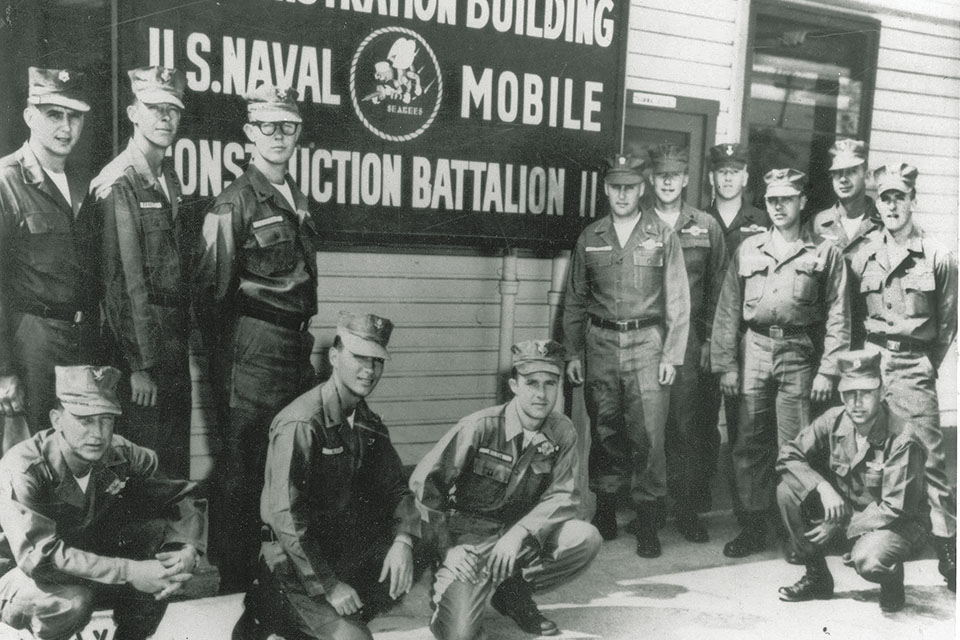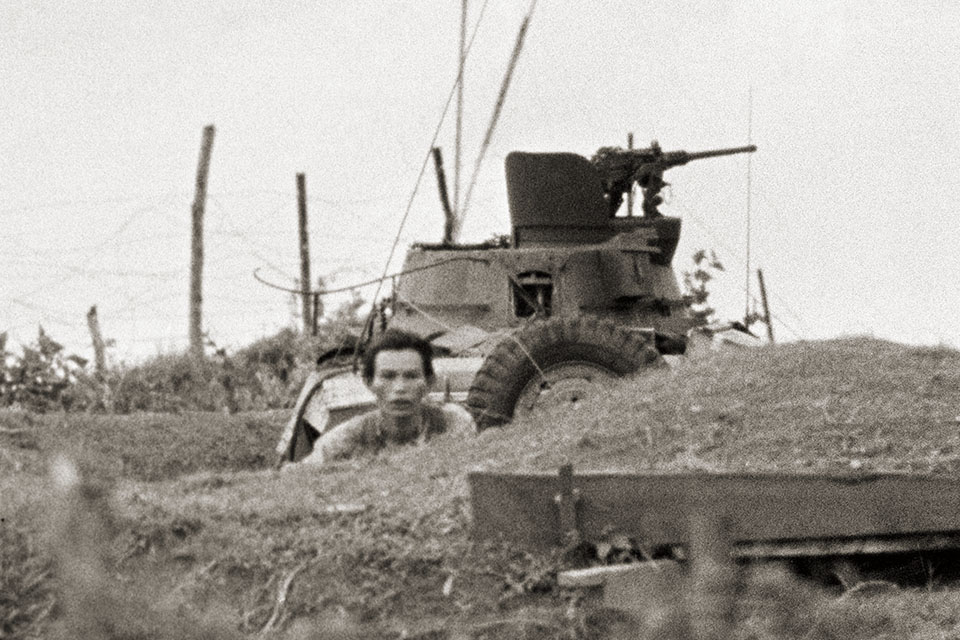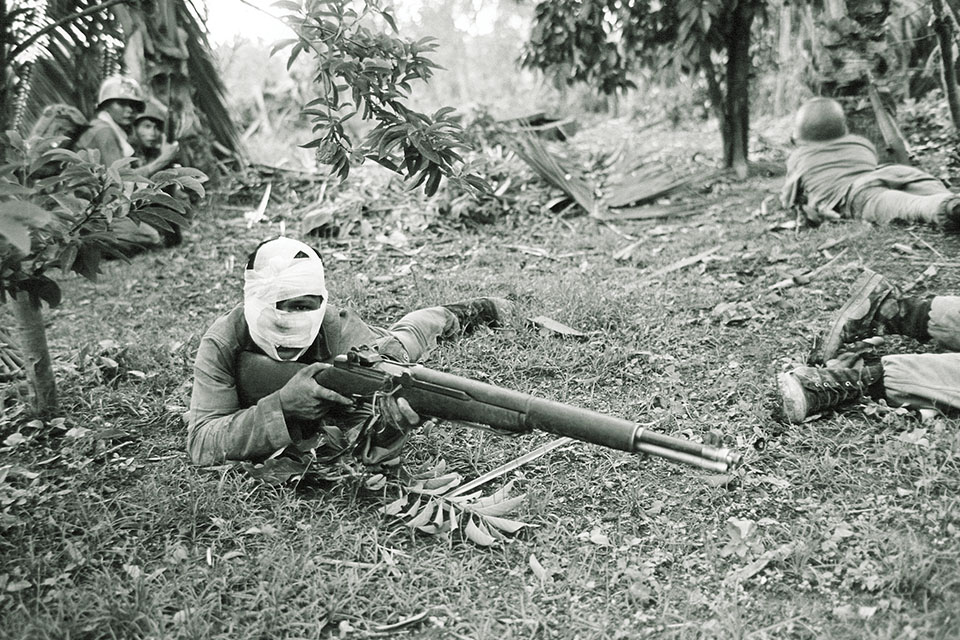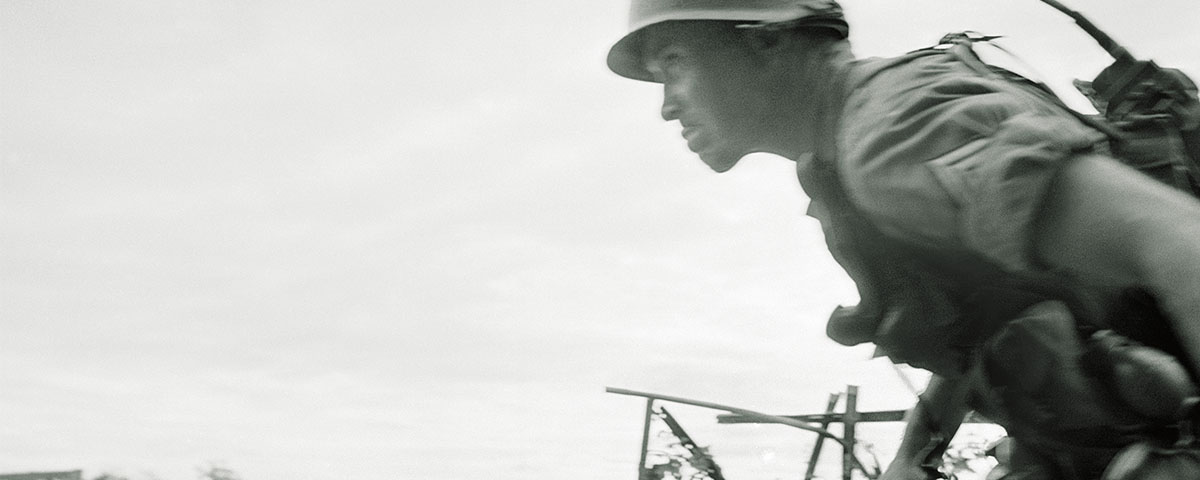In 1965, a powerful Viet Cong force threatened to annihilate a Green Beret base at Dong Xoai
At the end of May 1965, Seabee Team 1104, part of Naval Mobile Construction Battalion 11, was sent to a U.S. Special Forces camp near the village of Dong Xoai in Phuoc Long province, an area teeming with Viet Cong. Having just built a Special Forces camp at Ben Soi, near the Cambodian border, the 13-man Seabee team planned to reinforce the fortifications and work on other construction projects at Dong Xoai, near an important road junction about 55 miles north of Saigon.
A nine-man Seabee advance team reached Dong Xoai on June 4 and linked up with 11 Green Berets of Detachment A-342, 5th Special Forces Group (Airborne), who had been there since May 25. Also in the camp were about 200 South Vietnamese soldiers with a howitzer battery and 200 Montagnard tribesmen in Civilian Irregular Defense Groups—militias formed from local minorities ethnically distinct from the broader Vietnamese population.
Although the Montagnard CIDG troops were under the overall command of South Vietnam’s Special Forces, they showed only a nominal subordination to the Army of the Republic of Vietnam or the government in Saigon. In practice, U.S. Special Forces, who trained and led CIDG troops, often exercised control over them.
The Montagnards were in the main camp area, next to another compound with the South Vietnamese troops, the howitzer battery and the headquarters of the local district (a governmental organization similar to a U.S. county). The Green Berets and Seabees, split between the two compounds, had turned the camp into a heavily fortified outpost with strong defensive positions at key points, which enabled Dong Xoai’s garrison to have the entire area under its control.
At around 11:30 p.m. on June 9, the Viet Cong’s 272nd and 273rd regiments of the 9th Division, numbering 1,500-2,000 men, launched a two-prong assault. The 272nd Regiment hit Don Xoai village and the Special Forces camp. Meanwhile, the 273rd Regiment covered the routes and landing zones that the ARVN or U.S. forces were likely to use to assist the camp once it was under attack.
The Viet Cong launched their attack with a barrage of 60 mm motors and 57 mm recoilless rifles, simultaneously hitting the main camp/CIDG compound and the district headquarters. They destroyed the main camp’s dispensary, full of valuable medical supplies, as well as the radio equipment in the communications shack. During the fight, Special Forces Capt. Bill Stokes, the outpost commander, suffered serious wounds in both legs.
Meanwhile, Special Forces 2nd Lt. Charles Q. Williams, who was in the district headquarters compound, determined the location of the enemy’s main thrust and organized his men into defensive positions. He then ran to the district headquarters building to establish communications with Stokes, but the radios in the main camp had already been destroyed. Williams tried to run to Stokes’ position, but intense enemy fire, which wounded his right leg with shrapnel, forced him back to the district headquarters.

At 1 a.m. on June 10, in response to the VC’s opening barrage, a quick-reaction team of the 3rd Flight Platoon (“Bandits”), 118th Aviation Company, 145th Combat Aviation Battalion, was ordered to Dong Xoai. Within minutes of being alerted, two UH-1B Iroquois “Huey” helicopters armed with rockets and machine guns lifted off from Bien Hoa, the regional command center about 20 miles north of Saigon, and were in a position to engage the VC by 1:30 a.m.
Bandit pilot Chief Warrant Officer Ralph Orlando wrote in his diary: “The town and compound were in shambles. At least seven .50 cal. machine gun positions were located throughout the area. The VC even had flamethrowers and used human waves of troops to attack the SF [Special Forces] compound.”
When the Huey gunships opened fire to silence the machine gun positions surrounding the camp, they began taking enemy ground fire immediately. The lead chopper was hit and the fire team leader wounded, but the Bandit gunships stayed on site until they had expended all of their ammunition.
“We kept dumping our ammo and rockets till dawn,” recalled Pfc. Garrett Sargent, a door gunner from the 25th Infantry Division on temporary assignment with the 118th Aviation Company.
The Viet Cong followed up their initial assault with a 200-round mortar barrage, and around 2:30 a.m. they launched a massive attack against the earthen west wall of the CIDG compound.
Special Forces Spc. 4 Don McLaughlin, who was wounded and evacuated to a field hospital, told Daily News Briefs, a publication of Military Assistance Command, Vietnam, that “we were trying to fight them off, but they came swarming over the walls.” The Seabee team’s leader, Lt. j.g. Frank Peterlin, spotted an enemy soldier carrying a flamethrower and shot him. As the battle continued, an explosion blew Peterlin off his feet, and a bullet hit his right foot.
Stokes, the camp’s wounded captain, was carried to the district headquarters by Petty Officer 3rd Class Marvin Glenn Shields, a construction mechanic, Petty Officer 2nd Class Lawrence W. Eyman, a utilities man, and Special Forces Sgt. 1st Class James T. Taylor Jr., a medic.
As the Viet Cong poured into the CIDG and district compounds, Williams left the district headquarters to encourage the camp’s defenders to maintain their positions and fight. He was wounded in his thigh and left leg. When a jury-rigged, battery-powered field radio enabled the defenders to re-establish contact with the outside world, Williams headed toward the communications bunker and was hit again—this time in the arm and stomach.
But with Stokes even more severely wounded, command of the camp passed to Williams. The Viet Cong repeatedly attacked with flamethrowers, machine guns, recoilless rifles and small arms, and as the defense lines crumbled, Williams consolidated the Americans from both compounds into the district headquarters building and used the radio to communicate with air crews and direct airstrikes against enemy positions. They held off the advancing enemy throughout the night.
By the dawn hours of June 10 the Viet Cong set up a .30-caliber machine gun in a schoolhouse south of the district headquarters and fired relentlessly into the Americans’ last refuge. Williams knew that the machine gun had to be silenced if any of his men were to survive. He grabbed his only remaining heavy weapon, a 3.5-inch rocket launcher, and asked for a volunteer to reload once the two got close enough to the machine gun for Williams to fire at it. Seabee Shields immediately volunteered, despite being wounded and never having fired that type of weapon. The two men carefully maneuvered their way to a position near the enemy machine gun and destroyed it.
As Williams and Shields made their way back to the district headquarters building, a second machine gun was aimed at them. Williams was shot in the right arm and leg, while two bullets shattered Shields’ right leg. Williams was unable to move Shields but other Americans came to his aid, pulling the Seabee back to the building.
Meanwhile, the two Bandit helicopters returning to Bien Hoa around 4:30 a.m. discovered that the 118th Aviation Company had been activated, and all flyable aircraft departed by 6 a.m. on a mission to retake Dong Xoai. The aviators picked up elements of the 1st Battalion, 7th ARVN Regiment, 5th ARVN Division, and transported them to a landing zone for the assault.
Information regarding the chaotic situation at Dong Xoai was sketchy at best— just scattered intelligence regarding enemy strength and positions—and high-level commanders struggled to react to the devastating attack. The landing zone they chose for the South Vietnamese reinforcements’ first assault was an open field near the Thuan Loi rubber plantation, about 2½ miles north of Dong Xoai.

When the 7th ARVN Regiment arrived at the landing zone at 8 a.m., it dropped into a cleverly sprung Viet Cong trap. As the first of the 14 helicopters approached the landing zone, they held their fire, mistakenly thinking that friendly troops or civilians might be in the area. But the presumed civilians turned out to be Viet Cong fighters, who dove into bunkers and unleashed their weapons on the helicopters and ARVN soldiers as they were touching down. The American helicopters, in need of refueling, made a fast departure and escaped without major damage, but many of the South Vietnamese troops inside the fire-swept landing zone were quickly cut down.
The Hueys refueled, loaded the rest of the 1st Battalion, 7th ARVN, and flew to a different landing zone, the airstrip at the Thuan Loi plantation, but as before they were greeted by intense VC fire. As Blue Tail 1, from the 118th Aviation Company’s 2nd Flight Platoon, was lifting off after landing its troops, it was struck by a mortar round and rolled over and exploded. Killed onboard were the four crewmen and two U.S. Army advisers. Another adviser, who had hopped off Blue Tail 1 earlier, got on the radio to stop other helicopters from dropping down into the intense mortar fire—but then his transmission abruptly stopped.
The South Vietnamese soldiers again suffered massive casualties. “Of the 500+ troops lifted in [at the two landing zones,] about 250 are unaccounted for,” Orlando later wrote in his diary. It was now clear that further flights to reinforce the troops on the ground were too risky. All flights into what had become a VC “kill zone” were suspended.
Back at Dong Xoai, Williams was arranging for the evacuation of the numerous wounded while at the same time guiding Air Force strikes onto the Viet Cong positions. But with helicopter flights into the area suspended, he knew help would not be coming. The surviving Dong Xoai defenders were running dangerously low on ammunition, and as the VC massed for another attack, Williams withdrew the remaining defenders to a nearby howitzer position to make a last stand. When his men assembled there, they found 20 South Vietnamese troops still holding out.
At noon, the 118th Aviation headquarters in Bien Hoa received from Dong Xoai a chilling radio message, thought to have been sent by Special Forces Staff Sgt. Harold Crowe. “I’m using my last battery for the radio and there is no more ammunition,” it said. “We are all wounded, some of the more serious are holding grenades with the safety pins already pulled. The VC are attacking in human waves. The last wave has been defeated but we are expecting the next wave now.”
Upon hearing the message, the 118th Aviation’s commanding officer, Maj. Harvey Stewart, reportedly stood up and said, “I’m going in.” Stewart and five pilots and their crewmen boarded three Hueys and lifted off to try and rescue any Dong Xoai survivors still holding out on the ground.
As the three rescue helicopters and a gunship escort closed in, the Dong Xoai camp was designated a “free strike” area—meaning that American aircraft and artillery now had free reign to mercilessly pound it with ordnance. Air Force crews used napalm, bombs and rockets to buy some time for the defenders.
About 1 p.m., Stewart’s helicopters swooped in through heavy enemy fire and landed. Working in a blizzard of gunfire, they loaded the Americans and several Vietnamese fighters onto the waiting choppers. Stewart’s bravery and command of the rescue operation were later recognized with the Distinguished Service Cross, the Army’s second-highest valor award.
Meanwhile, two Americans were still on the ground—Seabee leader Peterlin and Senior Chief Petty Officer Johnny McCully, an equipment operator who had fought bravely, repeatedly exposing himself to enemy fire until a grenade wounded him. Both had become separated from the other Seabees during the chaotic withdrawal from the perimeter defenses. They were able to get out of the camp, however, and went into hiding for the rest of that day and night.

At 4 p.m. on June 10, the 118th Aviation Company and other units of the 145th Combat Aviation Battalion began flying in men from the 52nd ARVN Ranger Battalion to retake the Dong Xoai camp. They landed in a nearby soccer field, catching the Viet Cong by surprise, and American airstrikes continued to pound the area for the rest of the day. Enemy machine gun fire downed one Huey, killing the four crewmen of A Company, 82nd Aviation Battalion, but after hours of tough fighting, the camp was again in friendly hands by nightfall.
On the morning of June 11, the VC withdrew from Dong Xoai. Afterward, Peterlin and McCully emerged from hiding and were airlifted to safety. Both received Silver Star medals.
The casualty count for the 20 Americans at the camp included three Special Forces soldiers and two Seabees killed. Of the surviving 15 Americans, 14 were wounded. Additionally, about 43 CIDG Montagnards and South Vietnamese troops were killed.
On the enemy side, 134 Viet Cong bodies were found in the area of the camp, and other VC dead may have been carried off the battlefield.
Outside of the camp, American deaths included eight helicopter crewmen—four each from Blue Tail 1, 118th Aviation Company, 145th Aviation Battalion; and A Company, 82nd Aviation Battalion. Five U.S. Army advisers died—the three who had been passengers on Blue Tail 1 and two killed elsewhere while attached to South Vietnamese units. More than 400 South Vietnamese soldiers died in fights in the outskirts of the camp.
Severely wounded Seabee Shields was among those loaded onto the rescue helicopters, but died en route to medical help. “Shields was joking and cutting up to the end,” according to Petty Officer 2nd Class James Keenan, a hospital corpsman quoted in a Navy history of Seabee operations in Southeast Asia. “When he finally went under, it was very quiet, nothing dramatic. He just went to sleep. The last thing he did was to thank everyone who helped him.” Shields was posthumously awarded the Medal of Honor, and Williams also received the nation’s highest military honor.
For several days after the battle, the 118th Aviation Company brought in more South Vietnamese troops for operations in the area and carried out the wounded. On June 13, Special Forces Detachment A-311 arrived to begin rebuilding the camp.
—Dana Brenner writes about history for regional, national and international publications. He also teaches history, political science and sociology on the university level. Benner served more than 10 years in the U,S. Army.





